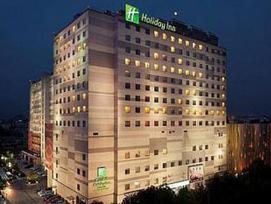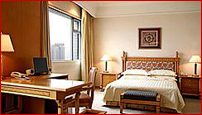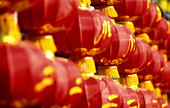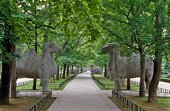|
Nanjing
City
4 days 3 nights Tour Route A
Nanjing Tourist Attractions:
Yangtze River Bridge, Dr. Sun Yat-sen's Mausoleum, Xuanwu
Lake, Mingxiao Tomb,
Zhonghua Gate, Former President's House of China, Confucius
Temple, Qinghuai Scenic Night Cruise
Highlights:
* Known as the Capital City of six dynasties in China's history,
Nanjing has a brilliant cultural heritage that worth a tour. For
almost two thousand years Nanjing has been a center of commerce,
politics, and culture
* This tour about covers all the prime areas of interest in
Nanjing, and accompanying you will be your local guide, who will
give you the best information and tips in order to ensure you a
great visit
* On your final night in Nanjing you'll go on a night cruise of
the Qianhuai River, Nanjing's central river, allowing you to see
the gardens, temples, and lanterns glowing in the light
B=(Breakfast) L=(lunch) D=(dinner) DEPARTURE: Daily |
|
| |
TOUR ITINERARY |
 |
Tour
code:
GWAC-NJ-01 |
|
DAY 1
|
Arrive in Nanjing
You will fly into the Nanjing airport or take a
train to Nanjing, and upon arrival you will be
met by your local English-speaking guide. You'll
be taken to your hotel, a 3 or 4 star hotel for
common tours, and a 5 star hotel for luxury
tours.
After getting some time to freshen up and
unpack, you'll get in a bit of sightseeing today
by visiting the Yangtze River Bridge. This is
the first bridge to be independently designed
and constructed by the Chinese themselves. The
bridge was added to the Guinness World Records
as the world's longest bridge featuring the dual
functions of a highway and a railway.
|
|
3 or 4 star for common; 5 star for deluxe |
|
DAY 2 |
Nanjing Tour (B, L)
Today will be a complete day of touring and
visiting Nanjing's attractions. After breakfast
in the hotel, we'll visit the tomb of one of the
most important figures in modern China at Dr.
Sun Yat Sen's Mausoleum. Sun Yat-Sen (Nov. 12,
1866 to March 12, 1925) was probably the most
important political figure and revolutionary in
China around the turn of the 20th century. One
of his legacies was publishing his political
philosophy called the "Three Principles" of
nationalism, democracy and people's livelihood.
He said that his three principles were inspired
by Abraham Lincoln's Gettysburg Address.
Understanding his life and influence in the
world will help people to understand modern
China and Taiwan.
He died in 1925 in Beijing. Just before his
death, he reiterated something he had said
before: “I wish that after my death I could be
buried at the foot of the Purple Mountain in
Nanjing because Nanjing was where the
Provisional Government of the Republic of China
was established, and we should never forget the
Revolution of 1911.�
The mausoleum is very big, and there is a big
gate at the entrance to the area in front of the
grand stairway. It was built between 1926 and
1929. In the center of the hall is a
4.6-meter-high statue, and there is a white
marble coffin. The mausoleum was built by the
Republic of China government. In 1929, his body
was carried there.
Next well take a stroll by Xuanwu Lake. Situated
at the foot of Mt. Zhongshan, Xuanwu Lake is a
beautiful scenic spot as well as containing one
of the three most famous lakes in Nanjing.
Surrounding it are Circumvallation, Mt. Jiuhua,
and Jiming Temple. The lake covers an are of 444
hectares with a coastline of kilometers in
circumferences. The history of Xuanwu can be
traced back to the Pre-Qin perio (21stcentury
BC-221BC). According to legend, in the Southern
Dynasty a black dragon was seen in the lake.
Chinese Daoists believed that the black dragon
appeared as the uniform of a turtle and snake,
called Xuanwu. Hence, the lake was called Xuanwu
Lake. Another legend stated that when Sun Quan,
the King of Eastern Wu Kingdom settled down in
the region, he brought water in and made this
lake. Geological studies show that the lake was
actually formed by the movements of the
geological plates when Mt. Yanshan was formed.
In the long history of China, the lake has been
used by many dynasties as an ideal place to
train their waterborne troops. Many military
demonstrations had been held here and a lot of
battles were fought here. Therefore, the lake
was also called “Military Rehearsal Lake� or
“Kunming Lake�. At the end of the Qing Dynasty,
the lake was turned into a park. Today, the lake
is much more beautiful with its water and
colorful mountains.
We'll learn a bit more about the ancient history
of this city at the Ming Xiaoling Mausoleum. It
is the tomb of Emperor Zhu Yuanzhang of Ming
Dynasty, which is one of the biggest Emperor
Mausoleums existed now. The construction of the
mausoleum began in 1383 and has more than
600-year history.
The mausoleum consists of two parts: front and
behind part, surrounding by 45-kilometer
stonewall. The mausoleum was heavily constructed
and planted. The front part begins from the
place of jumping off the horse at that time to
Sifangcheng (Rectangular city). You can enjoy
the stone animals guarding the tomb, a pair of
decorative columns, couples of ministers and
generals have been standing there for centuries
to accompany their Majesty beneath along the way
and the sacred way. The behind part includes
portal, stele inscribed with 4 Chinese
characters, which was written by Emperor Kangxi
in his third inspection tour, Xiaoling Hall, Bao
City and so on. Emperor Zhu and his queen ere
buried behind Bao City. The red portal of the
mausoleum lies in the north and face to the
south, which is the best direction for Chinese.
The name of the tomb "Mingxiao Ling" was printed
on the head of the gate. Two pavilions behind it
were destroyed, but you can still imagine the
fantastic scale from the relics.
|
|
3 or 4 star for common; 5 star for deluxe |
|
DAY 3 |
Nanjing Tour (B, L)
After breakfast we'll get started with the day's
sightseeing at the Zhonghua Gate, a relic of the
city's ancient city wall. Zhonghua Men Gate is
the largest castle-style gate among the 13
ancient city gates in Nanjing. It's the best
preserved and, architecturally, most complicated
ancient castle in the world. The elaborately
designed castle contains three closed courtyards
and four arched gates serving as entrances to
the city.
During the early 20th Century, Nanjing was
China's political capital (Taiwan still claims
Nanjing as its capital), and we'll see some of
the traces of that lofty past at the President's
Palace. The President Palace dates from the Ming
Dynasty, and was expanded and renamed the
"Heavenly King Palace" during the time of
Taiping's Heavenly Kingdom, a power established
by rebels during the Qing dynasty. In 1912 the
palace served as the headquarters of Dr, Sun Yat
Sen's government.
Then it is off to the Confucius Temple, a
reminder of the lasting legacy of the great
sage. Confucius (Kong Fuzi) who taught
philosophy in China 2,500 years ago is
considered the most important figure in the
shaping of ancient Chinese civilization as well
as the cultures of the countries of Japan,
Vietnam, and Korea. The Confucius Temple is
south of the city's central district. There was
a temple that was built in the year 1034 during
the Song Dynasty period on the banks of the
Qinhuai River. During the past millennium, it
was renovated, reconstructed, and enlarged so
that it became a large complex. It was used by
Confucian scholars. Next to it was the Jiangnan
Gongyuan that was the largest examination area
for people taking the imperial examinations and
the Xue Gong that was the Qing Imperial Academy
for training mandarins to govern the vast
empire.
We'll conclude your time in fitting fashion,
with a cruise down the scenic Qinhuai River.
Qinhuai River, a branch of the great Yangtze
River, is 110 kilometers (about 68 miles) in
length and covers a drainage area of 2,631
square kilometers (about 1,016 square miles).
The river was originally called Huai River, and
it is said that the river was channeled to the
city of Nanjing during the reign of Qin Shihuang,
so it was named Qinhuai River from then on.
Qinhuai River is the largest river in the
Nanjing City area and is the "life blood" of the
city. Qinhuai River is so fascinating that it
captures the imaginations of people both at home
and abroad. In ancient times, the river is lined
with tea houses, restaurants, brothels and
stores; crowded with boats, bright lanterns in
the evenings, music and laughter. Now it has
become the most unique cultural area with
distinctive local characteristics combining
commerce, tourism and folklore. With the
Confucius Temple at its center, this location
offers a combination of historical sites,
gardens, painted boats, streets and folk
customs.
Among the sights from the river, the painted
boat from which lanterns hang is the most
charming and attractive, and which adds a
festive feeling to the Qinhuai River in the
evening. Floating lights are the most famous
view on the Qinhuai River. On the river, any
boat or ship, large or small, will have hanging
on it colored lamps.
|
|
3 or 4 star for common; 5 star for deluxe |
DAY 4 |
Departure
Following breakfast in the
hotel, you'll be driven to the Nanjing airport
or train station, and you'll fly on to your next
destination, ending your stay in Nanjing. If you
would like to extend your stay in China then
please go to our China City
Tours and China
Package Tours pages to find out about more
of the great destinations in China we offer!
|
|
3 or 4 star for common; 5 star for deluxe |
|
|
|
|







